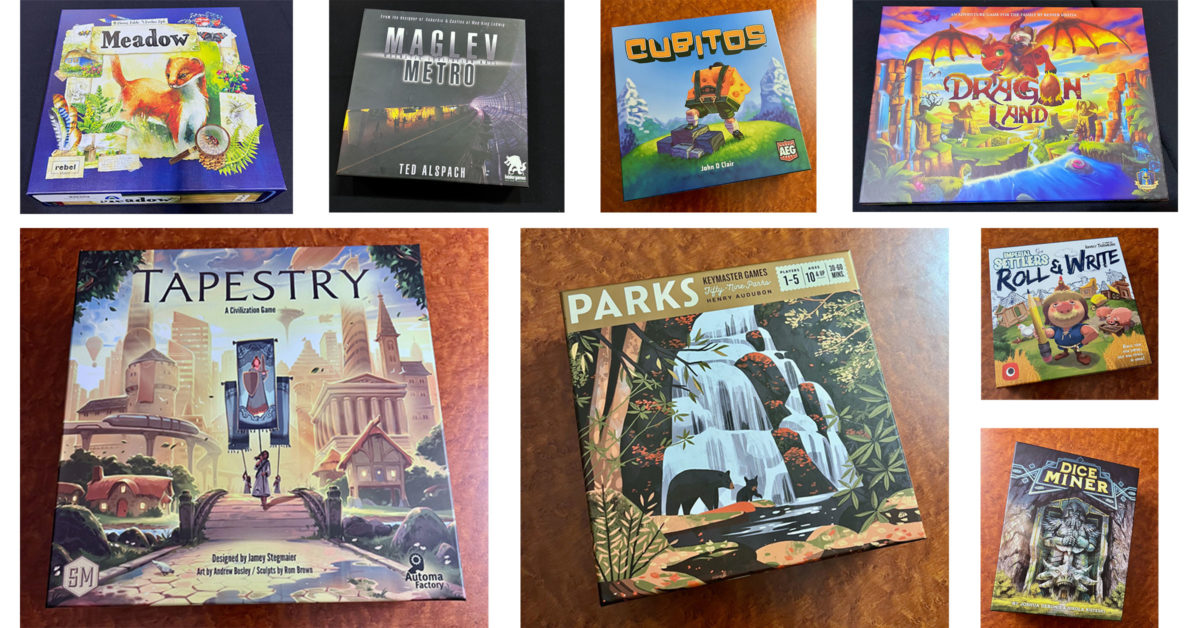See previous reports here: Day 1 | Day 2
On Wednesday we played eight games, including one from the prior day (have a guess). Two of them were on my “want to play” list for quite a while.
Maglev Metro

We started off with Maglev Metro. I had high hopes for this one — the theme looked interesting and the art too. Turned out to be a little complicated, especially as the first game of the day.
The game has a double-sided board, where you can build a train network either in New York City or Berlin. The game recommended NYC for the first play, so that’s what we did. The idea is to pick up passengers in different categories and deliver them to the stations where they’re trying to go, but first you have to build the stations and routes to them.
Your abilities are configurable, by which I mean you have a player board listing a bunch of attributes about your turn, like number of actions you have per turn, how many tiles of track you can lay in an action, how far you can move, how many passengers you can pick up or carry or drop off in one action, and so on.
These attributes are filled in with passengers that you drop off at the correct stations, so when you start, your abilities are limited and as you progress you start to be able to do more and more on each turn (you start out with a handful of passengers to begin with). Most of the attribute slots are color-coded, so passengers of a specific type can only go in specific spots on your board.
The interesting aspect is that you can spend an action to reconfigure your attributes (and how much you’re allowed to reconfigure is itself an attribute). It reminded me a bit of video games or RPGs where you can allot a pool of points to attributes to configure your character.
We had a bit of rule confusion about the beginning of the game (e.g. what counts as a station you can build to and visit at the beginning), but once we resolved that things went ok.
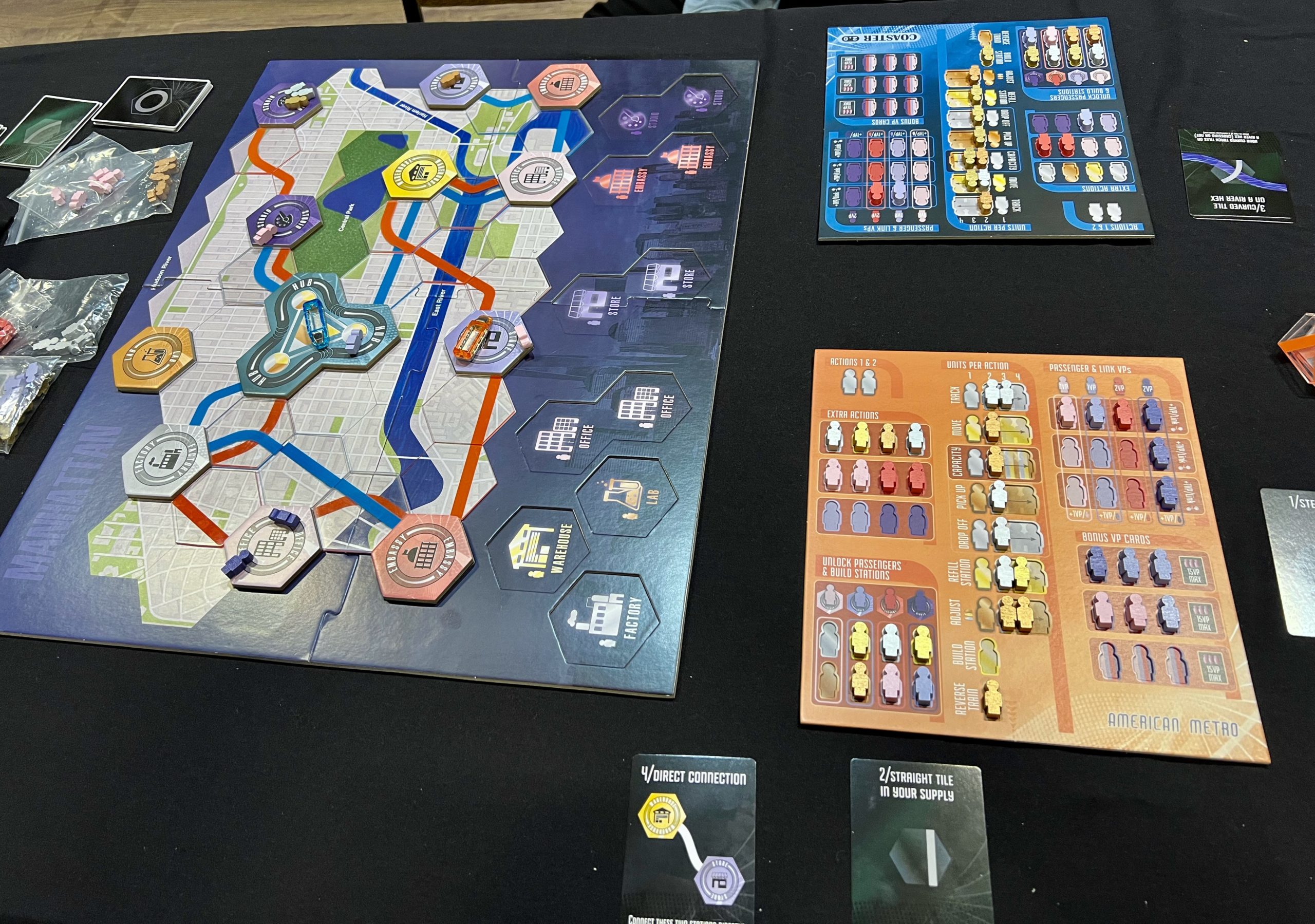
I really liked the build quality of this game. The board was substantial, and the passengers were pleasingly-colored. I liked the contrast between the commuter passengers in their pastel colors and the robots in their gold, silver and bronze. Your routes are built with lines on plastic tiles so they’re able to overlap, and there are curves of two different sizes so you can overlap curves that don’t hide each other. The trains are interesting, metal and translucent plastic, and the passengers fit neatly inside.
I imagine this would be great with more players, seeing the routes developing over the board and overlapping and such. We mainly played on opposite sides of the board, not competing directly until more toward the end of the game.
I liked the concept of this game, and the art. I thought the execution was a little off. Not just the rules confusion we had, but this also feels like a game that really punishes bad decisions or even just bad luck early on in the game. I think playing more games would help this — once you know how those early bad decisions might affect you, you’d know to avoid them. But for a first-time play, it can be rough. I’d play it again, and I bet it’d be better.
Dragon Land

Next up was Dragon Land, a re-release and minor update of a game by the same name from 2002. You play a team of three characters (abstract wooden figures that look vaguely like chess pieces), one each in three different colors, and hop around through Dragon Land trying to reach volcanoes to collect sets of gems and dragon eggs. Each of your characters also needs to find and collect a ring before the game is over, in order to score their color of gem. Along the way there are also tokens with special powers and even dragons you can hitch a ride on from volcano to volcano as a shortcut.
And that’s about it, really. You roll two dice, use one for one of your three characters and one for a different character. You score based on the sets of gems and eggs you collect (diamonds are wild, and can be used to replace any other gem). There’s just enough depth in planning out your moves to get the gems you need before the other player can, or stealing the dragon from them to take shortcuts. But definitely a game kids would be able to enjoy too.
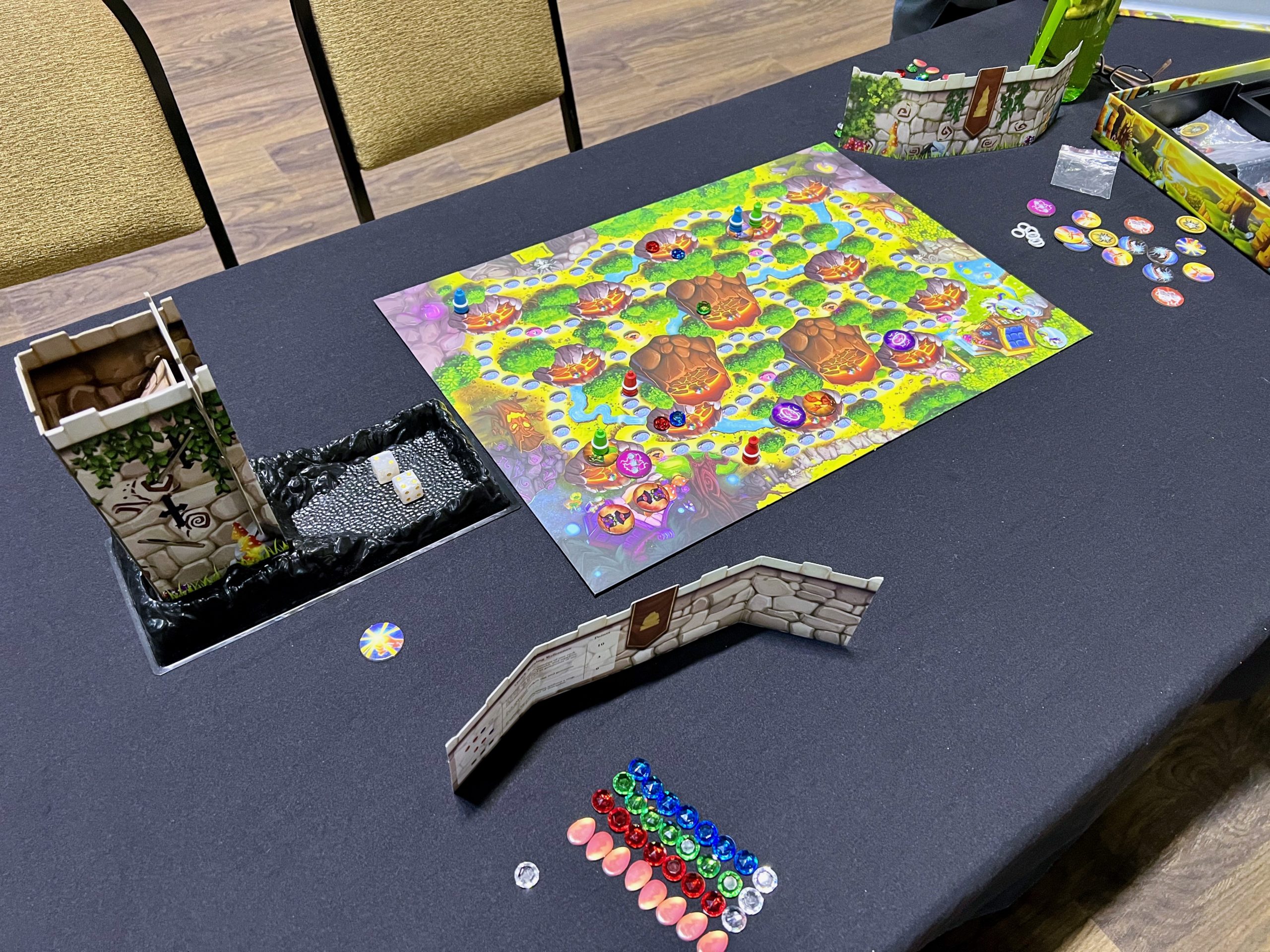
The game looks great, from the art on the board to the colorful gems and tokens to the castle-themed player screens to the dice tower. The one minor issue is that the paths and where you can access the volcanoes aren’t quite as clearly defined as I’d like. The dice themselves are nice as well. The manual kept referring to them as “destiny cubes” which I thought was just the game trying to be clever, but after our third-in-a-row combination of 2-4, I had a closer look and realized they weren’t standard, 1-6 dice.
This is an easy game to pick up, but with a deceptive amount of depth. It would be a good way to introduce someone, especially kids, to more advanced games.
Dice Miner

Dice Miner is a great new game, especially if you like to roll tons of dice.
You play dwarves mining mountains for dice, and there are lots of dice. The game comes with 60. Each round you fill up the mountain, then take turns choosing dice, usually from the top. Different colored dice do different things for scoring, and one face of each type is a mug of beer. You can share a beer, if you have one — you roll the beer die over to your opponent, but then you get to choose two dice from the mountain and you can take from the side (allowing dice on top to slide down and fill in the spots below). After all the dice are gone, you can use some of them to re-roll others, and then there’s a scoring round. You do this three times.
This game plays pretty quick and there’s plenty of player interaction. It’s nice, because to gain the share a beer benefit of choosing two dice, you have to give up a die to the opponent, often benefiting them rather than hurting them. The dice sliding down mechanic is nice too. There’s plenty of replayability, not just in the randomness of the dice, but you also select a character at the beginning of the game which provides a couple ongoing benefits.
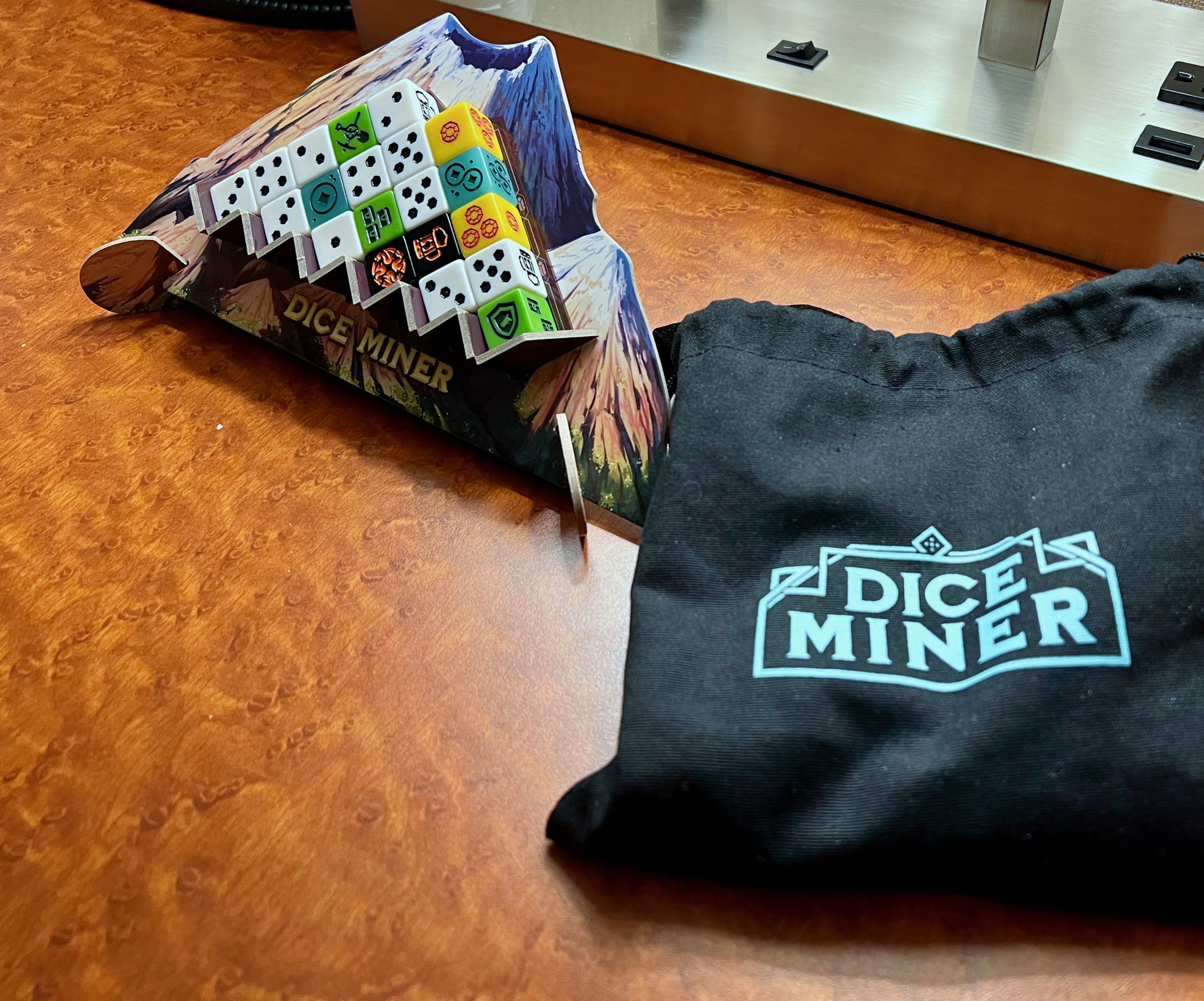
The components are great. The mountain works well and is way less fiddly to fill than I thought it would be. The dice are nice to look at and the art is interesting. We did have a minor rules confusion — you’re supposed to reroll all the dice you’ve collected in between rounds, and we just missed that step the first game we played. But it was quick enough we just played again with the correct rule, and it was much better.
I really enjoyed this one. It worked well at two players, and I think would be just as good at three or four. It’s not a heavy game by any means, but there’s plenty of strategy and important choices to make.
Meadow
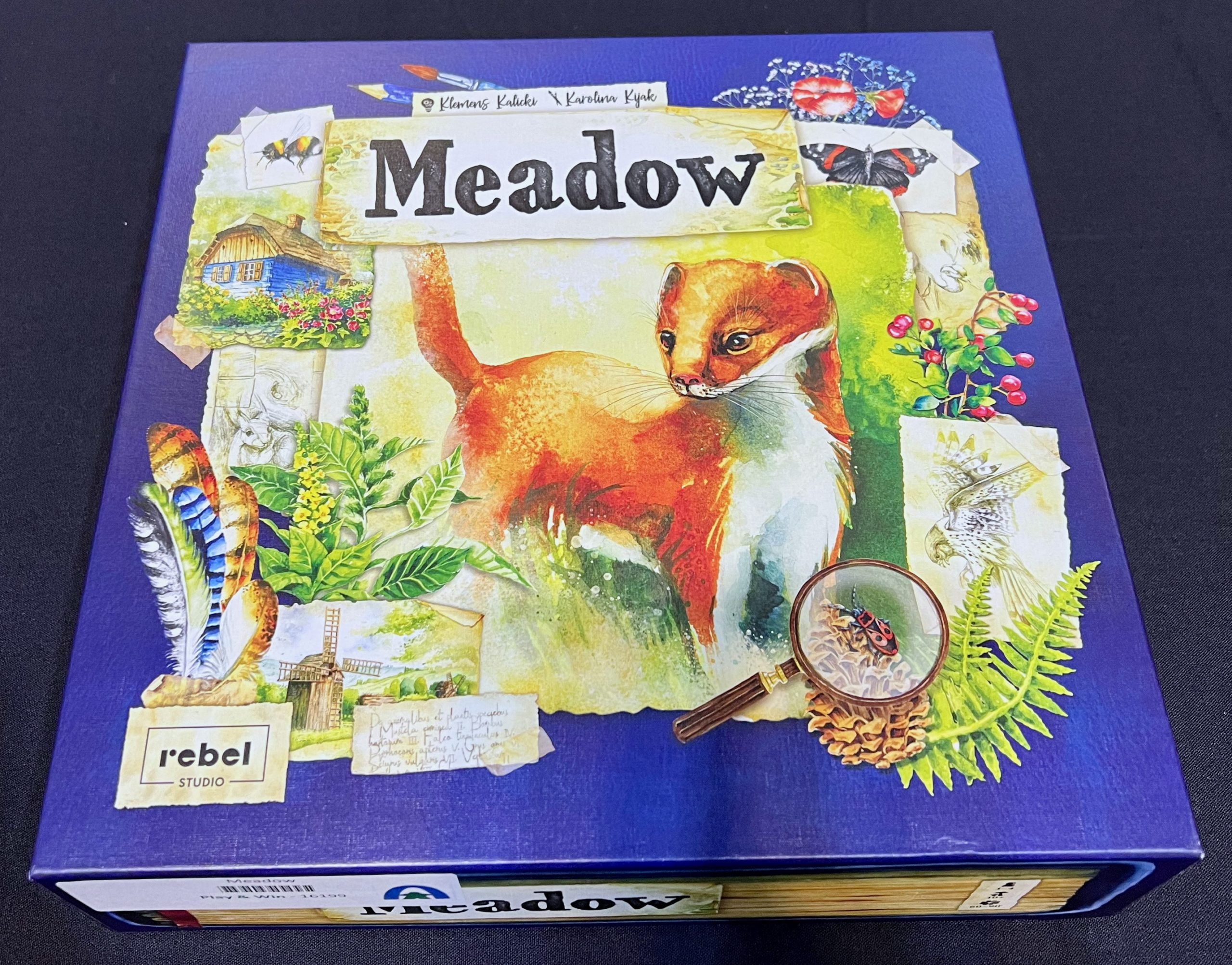
We played Meadow again. See my Day 2 post for its review.
Tapestry

Finally got a chance to play Tapestry. I’d seen this when it came out, and simultaneously knew it looked interesting and that it’d probably be a while before I got to play. It was designed by St. Louis’ own Jamey Stegmaier. It’s…big.
In Tapestry, you’re building a civilization from nothing all the way to AI Singularity and space exploration. You advance on four tracks: Science, Technology, Exploration and Military to, well, explore new regions and conquer them, as well as to gain new knowledge and invent stuff. Each player has a basic type of civilization, like Architects or Leaders, which provides some benefit. Each “round”, you play a new card to your tapestry to tell the story of your civilization and either provide an immediate effect or one that lasts throughout the turn.
I’m not going to explain all the rules here, because as I said, it’s a pretty complex game. You’ve got area majority, tile laying, hand management, tech trees, card drafting and upgrading, income. It’s all here. One interesting aspect is that players’ turns aren’t necessarily symmetrical, in the sense that choosing to spend income differently can allow some players to take more or fewer turns than others.
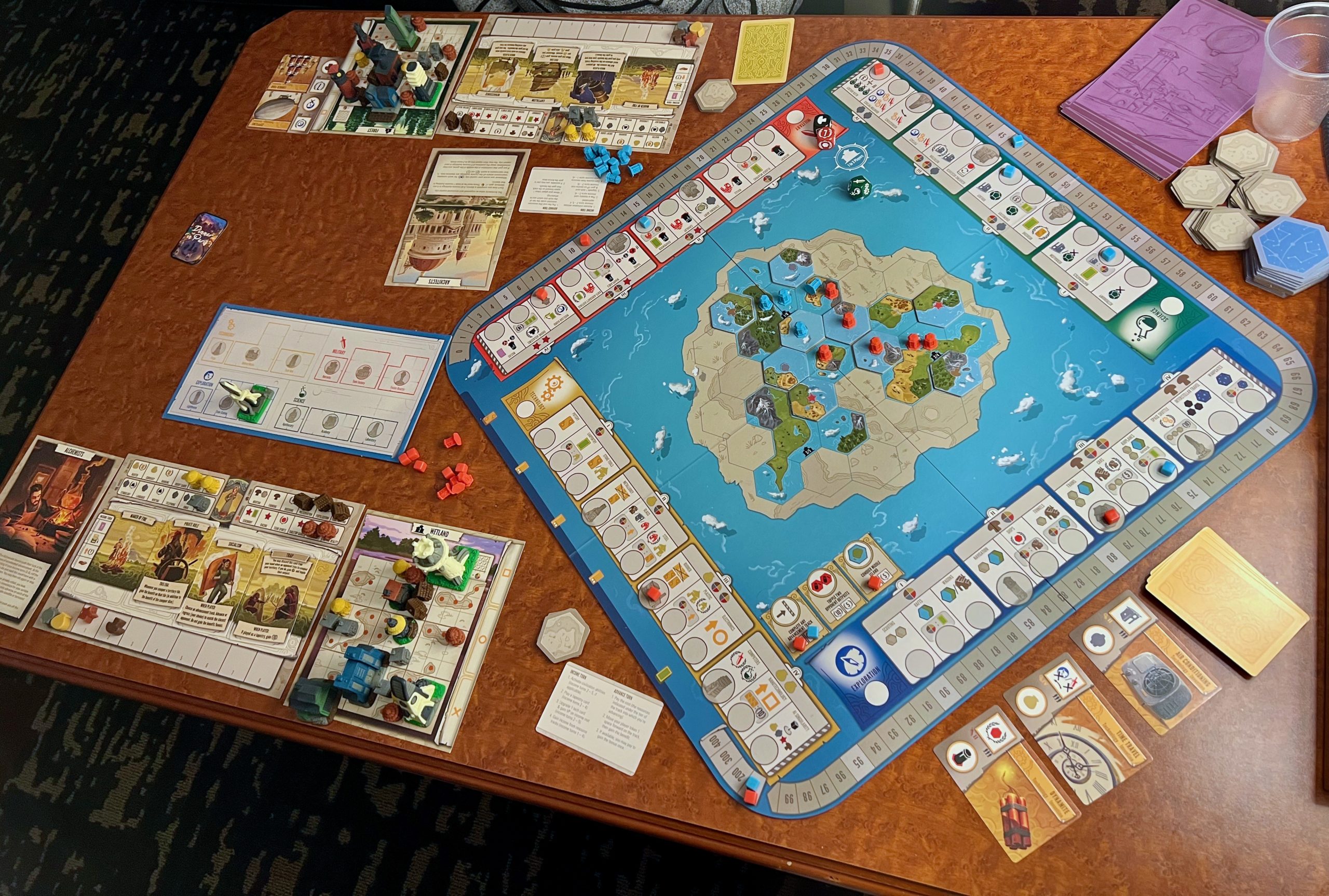
There’s a lot to this one. A couple different decks of cards, a couple different types of tiles, four tracks around the outside where you’re playing most of the time, four types of income, four types of building minis, three custom dice, player boards, and a whole bunch of custom specialized fully-painted building minis.
It’s an impressive table presence, and the special building minis are particularly great, even if they’re a bit hard to tell apart. The custom dice and income buildings are nice too.
One minor issue was encountering symbols that weren’t obvious and having to track them down. Wasn’t a big deal, just a minor annoyance several times in the middle of the game — and once you play through a couple times I imagine you learn them anyway.
The amount of options on a turn felt varied but not overwhelming. I liked the variety. I’d be concerned about length, but I think this would be fun with three or four players, just to see more variety in cards, strategies, etc.
Cubitos
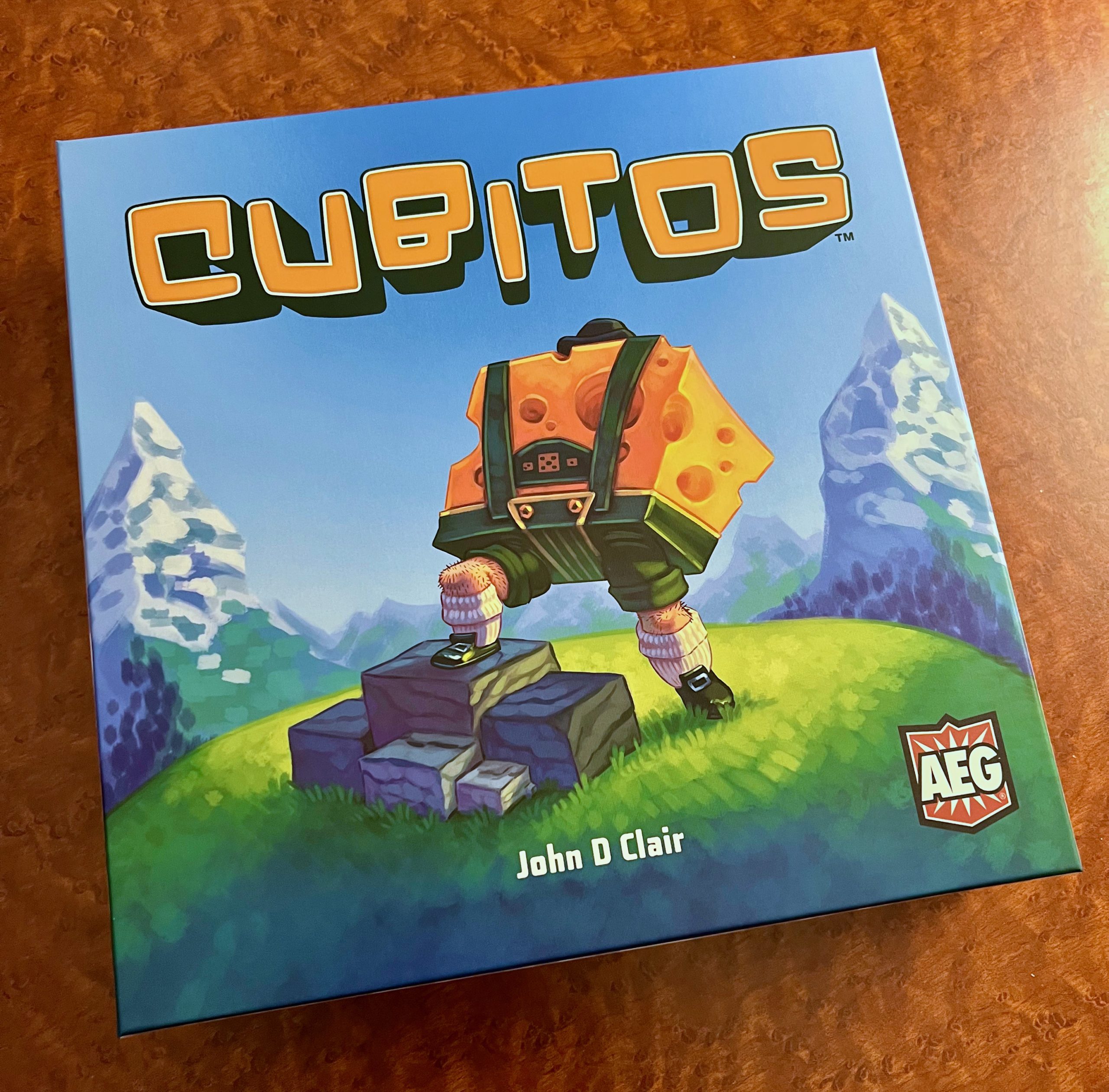
Cubitos was a lot of fun. Another good game if you like lots of dice. This is a game where you’re rolling dice to earn movement points, coins to buy more dice, and special abilities in order to move spots on a racetrack to beat the other players to the finish line.
You start with a bunch of basic dice, but the meat of the game is in buying dice that have special abilities. In addition to the basic dice, each game has eight colored dice. At the beginning of each game, you choose one card for each color of dice, and the card tells you what that color’s special ability is for that game. Some special abilities let you generate more coins or move farther, but there are lots of other, more interesting things too.
The push-your-luck dice rolling mechanic is interesting. You draw a certain number of dice from your pool, then roll all of them. If you get at least one non-blank face, you save it and then can choose whether to roll the blank ones again. If you ever roll all blank faces, you bust, and essentially end your turn.
Once you’ve decided to stop rolling, you proceed to the move phase, where you spend your movement going around the racetrack. There are lots of paths you can take, with obstacles, bonuses and other cool stuff. After you’ve moved, you can spend the coins to buy more of the colored dice, then you do it all again.
The components are mostly great. There are color-coordinated boxes for each of the sets of dice. They’re made to invert and serve as small trays/platforms for the dice during the game, which is nice, but they are a bit flimsy. Some plastic Chessex-type dice boxes would be great (but also more expensive). The art here is very good. There are four different racetracks in the game. The dice are a little small, but since you’re moving them around so much and rolling so many, I can see why they made that choice.
I had a lot of fun with this one, and I think the more the merrier with it, probably, especially since players take their roll phases simultaneously, then their move phases simultaneously. Unlike, say Tapestry, more players wouldn’t necessarily add a lot of time onto the game.
Imperial Settlers Roll & Write
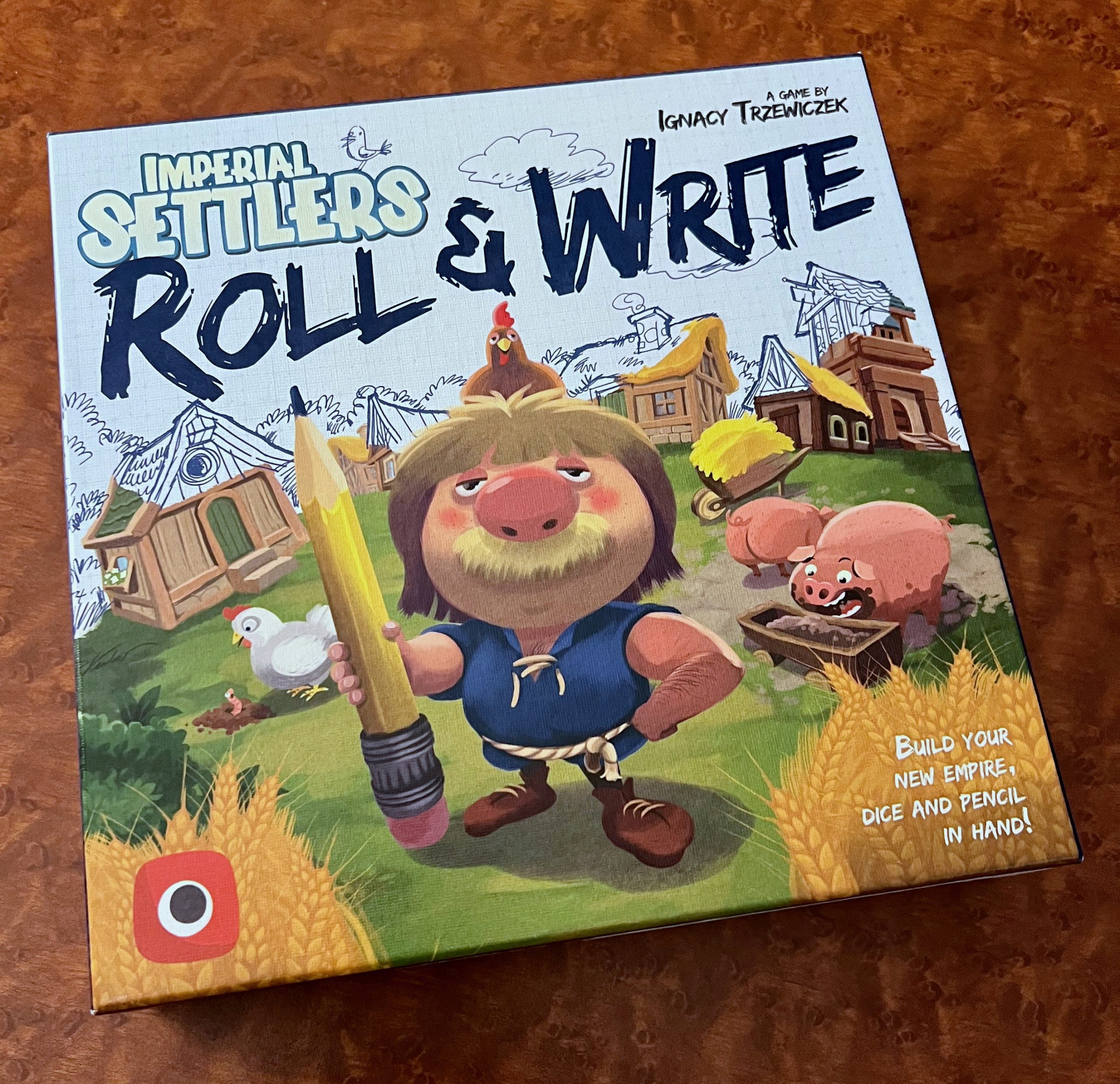
Imperial Settlers: Roll and Write is a, surprise, roll & write based on most efficiently using your workers (actions) and resources each turn. It is apparently based on another card game with which I am not familiar.
In the competitive mode, you and an opponent get a couple score sheets. You roll three resource dice to see what resources (wood, stone, food) are available this turn, and a worker die to see how many actions you can take. There are a few cards that provide bonuses for this turn, and each player takes one (ours were “1 extra worker”, “1 extra resource” and something I don’t remember because those were the only two anyone ever took).
Once you figure out the resources and actions available, you turn to your score sheets, and choose one square per action, as long as the resources are available. You eventually unlock fields where you can harvest additional resources, and construct buildings that give you certain abilities.
During the competitive game, both players are using the same score sheets — the only difference is in the bonus tiles you take in a round, and of course the choices you make throughout the game that unlock the abilities or extra resources that you can then use when your opponent perhaps cannot. There is a solo mode where each scoresheet is different to the last, providing some variety.
This one was just ok for me. Almost no player interaction, I didn’t think there was enough variety in what the buildings provided. If you really enjoy trying to maximize efficiency this one might have more appeal.
Parks

Now we’re talking. I’ve been looking forward to playing Parks for a while now, but haven’t had the chance.
Parks is a game about hiking through nature and visiting the national parks. You lay out a trail of different sites, and then, after figuring out the season’s weather pattern and making the according resources available on each site, each player moves two hikers down the trail.
Each site visited does something, usually gives you resources (water, sun, trees or mountains; there are also “wild” animal resources that are, well, wild). There are special sites that do other things. At the end of the trail, you can reserve a national park from one of the three face up or a face down one, you can visit one of the parks, including one you’ve previously reserved, or you can buy gear that gives you benefits. The parks provide points, there’s an occasional opportunity to take a photo for a point, and each player has a private goal.
You hike down the trail four times, each time adding one site to the trail, making it longer and longer, and changing the season.
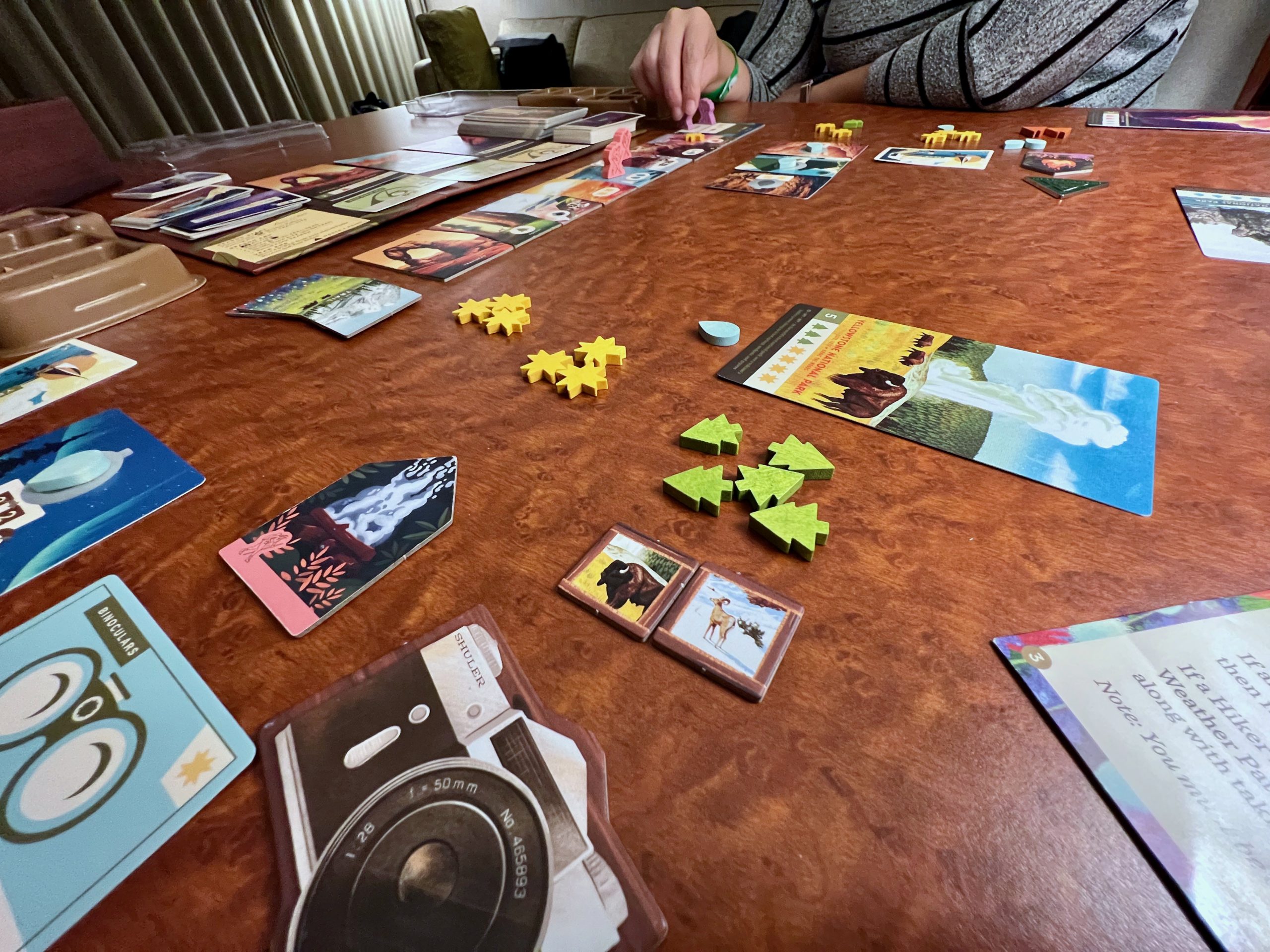
I enjoyed absolutely everything about this game. The turns were interesting. The player interaction (in addition to the other player getting your card first, there’s also getting to the end of the trail first to be first player back out next round, and occupying individual sites) was enough without being mean.
The components are great. The hikers, the resource tokens, the trail tiles. The first-player token is an enameled metal badge. There’s a large die-cut heavy cardboard camera tile that gets passed back and forth occasionally. The “wild” wild animal resource tokens are each a different animal. All great.
But the art is the star of the show here. The parks cards each have rich, lovely art for a different national park. And the game goes out of its way to credit the artist on each one, as well as in the instruction book (along with their website!). You almost can’t wait for the next parks card to come out just to see which park and the art on it.
The variety in the layout of the trail each season, the season card that changes the weather pattern, the gear and parks available, the individual goal, and the choices of your opponent would seem to make it pretty replayable, and there’s also a solo mode.
What a great game. It was also fitting that our very own local park managed to find its way onto the board during out game.

